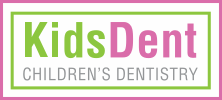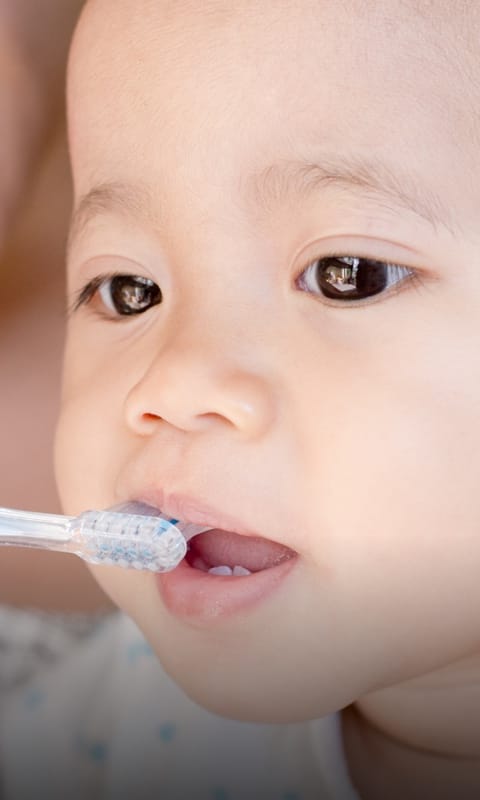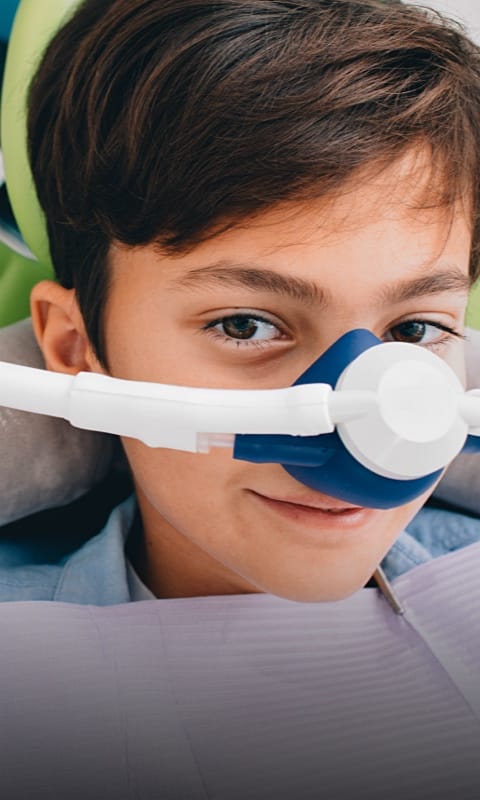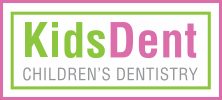Find the Answers to Your Questions
At What Age Should My Child First Visit A Dentist?
As paediatric dentists, we recommend your child have their first oral health exam within 6 months of their first tooth or by their first birthday, whichever happens first.
When Should My Child Start Using Toothpaste?
Training toothpaste without fluoride is a good way to introduce the texture of the paste on the toothbrush for young children. However, the mechanical movement of the bristles of the toothbrush is what removes the plaque and bacteria from the teeth and gums. We will help guide you when it’s the best time to introduce fluoridated toothpaste. It is not the same for every child.
Once children use fluoridated toothpaste, parents are encouraged to start using only a smear of fluoride toothpaste on their child’s toothbrush. Use a soft infant toothbrush to brush their teeth. We will give you an age and size appropriate toothbrush at your child’s first visit. As the child grows, the amount of toothpaste can be adjusted to pea sized.
How Often Should I Change My Child’s Toothbrush?
We recommend changing your child’s toothbrush every 3 to 4 months. Children can be hard on their toothbrushes, however, so if the bristles are frayed or worn, we recommend replacing the toothbrush regardless of its age.
We also encourage storing your child’s toothbrush somewhere safe where it will not be contaminated with bathroom bacteria.
When Should I Let My Child Start Brushing Their Own Teeth?
Young children do not quite have the dexterity to efficiently clean their own teeth. Children under 2 years should have their teeth brushed by an adult, using a smear amount of toothpaste and gentle pressure. Speak to us and we will recommend if your child would benefit from fluoridated toothpaste at this age.
There is no magic age when a child can brush their own teeth. It depends on the child. Some indications that your child is ready to brush their own teeth include:
- They can colour in between the lines
- They can trim their own finger nails
- They can tie their own shoe laces
Children who have braces should have adult supervision when brushing as well.
My Kids Love Candy! Do I Have To Remove All Sweets to Avoid Cavities?
We all deserve the occasional treat, including kids. While you do not have to remove all candy from your child’s diets, it is important to minimize the number of sugary sweets they consume.
We classify sugary treats as red, yellow, or green light treats. We recommend that red light treats should be avoided. Yellow light treats are more acceptable in moderation, but not all the time. Green light treats are fine to consume more often.
Red Light Treats:
- All types of juice, chocolate milk, yogurt drinks, and pop
- All chewy and sticky foods, like gummy treats, gummy vitamins, Fruit Roll-Ups, Fruit to Go bars, dried fruit, cotton candy, granola bars, chocolate bars with sticky centres
- Goldfish crackers, cheezies
Yellow Light Treats:
- Plain chocolate with no sticky centre, like Hershey’s chocolate, Kit Kat, Aero, M&M’s, Smarties, Coffee Crisp, Maltesers, or Reese’s Peanut Butter Cups
- Cupcakes and cake
- Cookies
- Doughnuts
- Ice cream
- Pretzels
Green Light Treats:
- Fresh fruit
- Raw veggies and hummus
- Cheese
- Nuts
- Dry granola and low-sugar yogurt
- Plain popcorn
How Do I Know if My Child Has a Cavity?
Tooth decay can lead to cavities (caries). As soon as your child has teeth, they are at risk for developing cavities.
Children may not have symptoms such as pain or swelling, but still have dental decay in their teeth. The dentist will examine the teeth visually, but also may need to take x-rays to detect cavities hiding in between the teeth. Some children eventually may have pain, swelling, fever, and/or sensitivity to certain foods like sweet food or hot and cold drinks.
You can help your child by watching for these signs of developing cavities:
- White spots forming on the teeth mean the enamel is starting to break down.
- Sometimes cavities can have a brown or black colour.
Does My Child Really Need X-Rays? Are They Safe?
Yes, even children need the occasional dental X-ray. We will recommend x-rays for your child only when we determine they are necessary.
Dental x-rays (radiographs) are important diagnostic tools that help your dentist see areas of your teeth not visible during an exam. They are extremely useful for:
- Detecting dental decay
- Catching bone diseases
- Detecting tooth defects and anomalies
- Detecting dental problems due to an injury to the mouth or dental trauma
- Assessing erupting and developing teeth
- Evaluating jaw growth and development
- Assessing orthodontic concerns
At KidsDent, we follow the ALARA principle (As Low As Reasonably Achievable). We use the fewest radiographs possible so our patients are exposed to the least amount of radiation. We also use digital radiography, which uses less radiation than conventional x-rays.
To help protect the children, we take all precautions during x-rays. X-rays are a diagnostic tool, and are required for a full and proper dental diagnosis. Defer taking x-rays may lead to pain, infection, and potential complications with the developing permanent teeth.
Is Thumb-Sucking or Pacifier Use Harmful to the Teeth?
It is natural for babies and toddlers to suck their thumbs or pacifiers (also called non-nutritive sucking) because it helps them relax. Non-nutritive sucking has minor impacts on developing teeth in children under 3.
The effects thumb- and pacifier-sucking have on your child’s dental development depend on the frequency, duration, and intensity. Non-nutritive sucking can affect tooth alignment and bite. Many children abandon this habit between ages 2 to 4. This is early enough that the affected bite may self-correct or result in a less severe orthodontic issue.
By the time your child is 3, a pacifier is better than their thumb or fingers. A pacifier gives you more control over how and when your child uses it. However, it is ultimately best to help your child give this habit up before their permanent teeth come in around age 5 or 6.
What Are Dental Sealants & Are They Beneficial?
Dental sealants are thin resin coatings painted on the chewing surfaces of the back molars. They are easily applied and relatively cost-efficient. They are also one of the most effective ways to reduce the risk of tooth decay and help prevent cavities.
The Canadian Dental Association supports the use of dental sealants for both primary and permanent teeth based on a cavity risk assessment performed by dental professionals.
What Do We Do if Our Child Has a Tooth or Mouth Injury?
Dental emergencies come in many forms. From broken and knocked-out teeth to toothaches and jaw fractures, children can experience many types of dental accidents.
If your child sustained a head injury as well as dental trauma, please visit your nearest hospital or emergency room. Head injuries should be cleared by a physician before you see us for a dental evaluation.
Our office is equipped to handle many types of dental emergencies. Please contact us as soon as possible after the injury. The earlier we see your child, the better the treatment outcomes may be.
Should My Child Wear a Mouthguard When Playing Sports?
Yes, children should wear a mouthguard when playing sports. Mouthguards are simple tools that help protect your child’s teeth, gums, cheeks, and lips from injuries. Mouthguards can also help reduce the risk of a jaw fracture by absorbing the force of a blow to the jaw.
Any time your child participates in a sport where they may make contact with other players or surfaces, they should wear a mouthguard. This can include activities such as:
- Football
- Hockey
- Basketball
- Skiing
- Baseball
- Soccer
- Wrestling
- Lacrosse
- Rugby
- Gymnastics
- Martial arts
- Skateboarding
- In-line skating
- Cycling
Children with orthodontics can also wear mouthguards. We can help you and your child choose a suitable and effective mouthguard for their unique teeth and chosen activity.
What Do I Do if My Child Is Scared of Going to the Dentist?
Anxiety about visiting a dentist is common. At KidsDent, we will try to help prevent the dental anxiety from becoming a future dental phobia. Many cases of dental fear begin in childhood and can result in avoidance in later years. Oral health care is such an important part of overall health, so frequent dental visits are essential.
We believe that honesty is the best policy. Always be honest with your child about their dental appointments. Speaking pleasantly about dental visits is a good way to create a positive mindset about the dentist and oral care at an early age.
Before your child’s first appointment, you can introduce them to cartoon or literary characters who also visit the dentist. Dora the Explorer, the Berenstain Bears, and Peppa Pig all go to the dentist, and their books are adorable. These books can help prepare for their dental visit and help ease their fear of the unknown.
Is Sedation Dentistry Available at Your Clinic?
Sedation dentistry can be a valuable option to treat your child’s dental needs safely and help encourage a positive experience. We offer many types of sedation at KidsDent, including:
- Nitrous oxide (laughing gas)
- Oral conscious sedation
- General anaesthesia
We will always have a thorough discussion with you about all your child’s sedation options. It is important to us that you make an informed decision for your child.
Learn more about our sedation dentistry options.
Visit Our Clinic
How to get there?
KidsDent is located in the uniquely shaped Royal York Medical Centre, on the corner of Royal York Road and Summitcrest Drive.
Our Address
- 1436 Royal York Road, Suite 202
- Etobicoke, Ontario M9P 3A9
Contact Information
- Phone: 416-249-3710
- Email: [email protected]
Hours of Operation
- Monday: 8:30 AM – 3:00 PM
- Tuesday: 8:30 AM – 3:00 PM
- Wednesday: 8:30 AM – 3:00 PM
- Thursday: 8:30 AM – 3:00 PM
- Friday: 8:30 AM – 3:00 PM
- Saturday: Closed
- Sunday: Closed
Why Choose a Paediatric Dentist?
For Kids

Our paediatric dentists know exactly how to make your child’s dental appointments fun and exciting while helping them build healthy, lifelong oral habits to keep their teeth strong.
Learn MoreFor Parents

Children have different dental needs than adults. Paediatric dentists undergo specialized training to give children the extra care and attention they need.
Learn More





